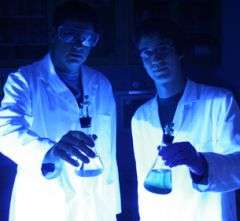Shedding light on ancient oceans

(PhysOrg.com) -- There's a powerful source of energy humming away inside a laboratory at the University of Alberta. The energy is ultra-violet light, and it packs the same spectrum of rays that kept this planet lifeless for billions of years.
Kurt Konhauser, professor of earth and atmospheric sciences, says he's using that light to recreate Earth's ancient atmosphere inside a box about the size of a kitchen dish washer.
"We're trying to find out how life evolved in the presence of ultra-violet radiation."
Three years ago, Konhauser and researcher Stephan Lalonde converted the light box from a standard incubator. The box is about the size of kitchen dish washer. Lalonde says its array of UV lights recreates a frightening time.
"There was no oxygen on the planet, so there was no ozone layer, nothing to filter out UV radiation from the sun. It's hard to imagine anything surviving, but we know it did."
The light box is one-of-a-kind, and harnessing all that sunlight in a box was a learning experience.
"The UV light was actually eating through the box," says Lalonde. "It rusted the stainless steel interior walls. We've had to replace hinges and the door handle because the metal deteriorated in the presence of this light."
The effects of those UV rays are unimaginable today, but a researcher working with Konhauser and Lalonde found out the hard way just how closely the light box matches the sunlight of three billion years ago. In less than 20 seconds the researcher got a taste of what a bad day at the beach is like under unfiltered sunshine.
"When you see a blue light you don't think it could be harmful so he just reached in; he just cracked the door to make a quick little adjustment."
Lalonde was there when the researcher saw the light.
"He walked into the office and told us his face felt hot. It was beet red, except for the classic raccoon look where the safety goggles covered his eyes."
A lesson learned. Luckily the price was just a sunburn. The learning curve for using UV lights in a small space has been steep.
"The first time we ran it, we hadn't calibrated our lights properly," said Lalonde. "They were much too strong. We actually turned some oxygen in the chamber into ozone."
Low-level ozone is another word for smog. Konhauser shakes his head when he recounts the story of the cloud in the light box. "We created a mini L.A. smog experience right here in the lab."
Now the technical bugs have been worked out and attention is focused on finding out how bacteria in a flask of water cope with UV light. By constantly changing the composition of the water, Konhauser and Lalonde are hopeful that one day bacteria in the flask will survive. Konhauser says that will be a big moment.
"That can take us back to the moment for the first plankton to survive on the surface of the ocean," he said.
From his past work involving iron and bacteria Konhauser has an idea of what might have happened.
"We know there was abundant iron and silica in the oceans in Earth's past."
He believes the microorganisms developed a sort of sunscreen.
"It's possible the bacteria became coated in this residue and it filtered out the UV rays."
In the real world it took hundreds of millions of years for the ocean's chemistry to change. The research team is not predicting when they can recreate the moment life began surviving on the ocean surface, but Konhauser says it's important to try.
"If we can determine how life adapted and began to flourish in such harsh circumstances, we'll have some idea of how we can adapt to the changes we're experiencing in Earth's atmosphere and chemistry today."
Provided by University of Alberta


















